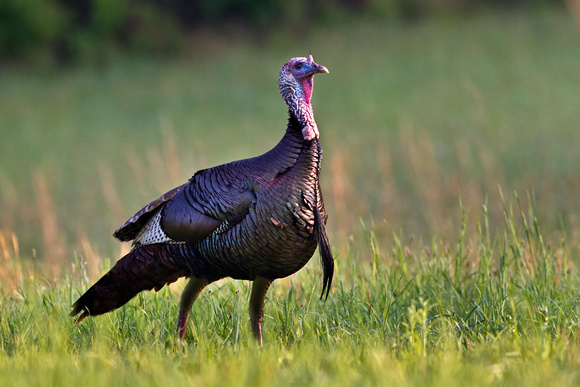Second article of a two-part series on the wild turkey in Kentucky.
Wildlife trades were an important component of wild turkey restoration efforts in Kentucky in the 1970s and 1980s.
In the late 1970s turkeys were obtained from private hunting clubs in Mississippi and Arkansas, in exchange for white-tailed deer. These deer-turkey trades lasted from 1978 until 1981 and provided around 400 birds.
In 1978 the statewide flock was estimated to number about 2,380, and hunters harvested 44 birds.
The short term management goal was getting birds established in all counties with suitable habitat. Preference for releases was given to the best areas available, where several counties adjoined. In the 1980s, Kentucky’s wild turkey restoration efforts shifted into high gear.

In the spring of 2010 Kentucky’s wild turkey flock was estimated to be about 220,000, and the state had about 90,000 wild turkey hunters. The final harvest for the 2010 spring season was 36,094, an increase of 24 percent over the previous record. (Photo Provided)
The Missouri Department of Conservation started providing turkeys in 1982 to Kentucky in exchange for river otters, which were purchased from a private source in Louisiana.
In 1985, the Iowa Department of Natural Resources started providing turkeys in exchange for otters. These trades provided several thousand birds over the years and were an important part of Kentucky’s restoration program. Small numbers of birds were also obtained from several other states.
Live Trapping and Relocation
In-state live trapping of turkeys with rocket nets began in 1981 and gradually increased the number of birds available for relocation. From 1978 through 1997, 6,760 birds were released on 430 sites across Kentucky, establishing small flocks in every county.
By the late 1980s, these scattered wild turkey flocks in Kentucky’s counties began to grow rapidly. Kentucky hunters experienced good hunting opportunities in all 120 counties during the 1990s, and posted eight record harvests in the spring between 1989 and 1998.
During that time, wild turkey populations across the country were increasing dramatically, too. According to the National Wild Turkey Federation (NWTF), the spring wild turkey season in 1991 was the first time hunting was open in all the 49 states that had wild turkey populations.
Wild Turkey Restoration Ends, First Fall Season
Wild turkey restoration in Kentucky ends in 1997. By that time the state’s wild turkey population had grown to around 130,000 birds. That same year, the state’s first fall seasons were held, and hunters could take birds of either sex.
Eventually, the seasons would include a fall archery turkey season that ran concurrently with archery season for deer, and two, seven-day shotgun fall seasons for turkeys, one in late October and one in early December.
The fall season bag limit is four turkeys, with restrictions, but it’s more liberal than the spring season, which has a bag limit of two bearded birds.
The record fall turkey harvest occurred during the 2004-05 season when 6,589 birds were bagged: 41.7 percent toms, and 58.3 percent hens. Hunters typically take more hens than gobblers during the fall season.
First Youth Season
Another milestone was reached in 2002 when the first ever youth-only spring wild turkey season was held in Kentucky on the weekend prior to the opening of the general season. Wildlife managers hoped that a season for boys and girls under age 16 years of age, mentored by adults, would serve as an introduction to the sport. Their goal of attracting 2,500 hunters, with a harvest of 1,000 gobblers, was easily surpassed.
Upward Harvest Trends
For the 10-year period from 2000-09, the wild turkey harvest in Kentucky increased by 59 percent, from a low of 18,243 to a high of 29,008.
The 2010 spring season yielded yet another wild turkey record harvest, as predicted by Steven Dobey, who was wild turkey program coordinator at the time.
“There were lots of 2-year-olds because of record reproduction in 2008. It was a great hatch,” he said.
The annual brood survey showed an average of 3.7 poults per hen, one of the highest numbers ever observed in Kentucky.
In the spring of 2010, Kentucky’s wild turkey flock was estimated to be about 220,000, and the state had about 90,000 wild turkey hunters. The final harvest for the 2010 spring season was 36,094, an increase of 24 percent over the previous record.
Kentucky Becomes Top Turkey Hunting Destination
By 2013, Kentucky had become the top turkey hunting destination in the region. For the first time, more birds were killed per square mile in Kentucky, than in any of the seven adjoining states. A total of 32,498 bearded turkeys were taken during the 23-day spring season.
Hunters in Kentucky bagged .82 birds per square mile (640 acres) and Tennessee was second, close behind with .80 birds per square mile. The turkey harvest per square mile in the other six states (Missouri, Illinois, Indiana, Ohio, West Virginia and Virginia) was much lower.
Carrying Capacity Reached in Some Kentucky Counties
In the six seasons after that record harvest in 2010, the number of wild turkeys taken during the spring season in Kentucky averaged 31,607, with only one season having a harvest below 30,000 (29,943 in 2014).
For more outdoors news and information, see Art Lander’s Outdoors on KyForward.
The trend is statistically stable, and there is growing evidence that turkey flocks in some counties are nearing, or have reached, carrying capacity.
“Nobody really knows how to determine if carrying capacity has been reached,” said Zak Danks, who became wild turkey program coordinator in the July 2016. “We do know our restored population has been growing fast and that at some point carrying capacity (maximum sustainable population) will be reached.”
Danks said he believes Kentucky’s wild turkey population numbers somewhere between 200,000 and 240,000.
Population growth is continuing in a majority of Kentucky counties. “If you look at the periods, before and after the 2010 record harvest, there were harvest decreases of at least five percent in 15 counties, harvest increases of at least five percent in 89 counties, and stable harvests in 16 counties,” said Danks.
Yes, some of Kentucky’s top turkey hunting counties are experiencing declines in poult production and wild turkey harvest, but many of these same counties were the ones stocked earliest in the restoration.
“(Declines) are concerning, but not unexpected,” said Danks. “What that really tells us is that some of our populations have approached carrying capacity.”
Read part one of the series on the wild turkey in Kentucky.
Art Lander Jr. is outdoors editor for NKyTribune and KyForward. He is a native Kentuckian, a graduate of Western Kentucky University and a life-long hunter, angler, gardener and nature enthusiast. He has worked as a newspaper columnist, magazine journalist and author and is a former staff writer for Kentucky Afield Magazine, editor of the annual Kentucky Hunting & Trapping Guide and Kentucky Spring Hunting Guide, and co-writer of the Kentucky Afield Outdoors newspaper column.
























Would you please remind me the name of the man that did all the trading to bring the original TURKEYS to
Kentucky. I hunted with him in Campeci Mexico when he had a heart attack and died the following week.
My 77 year old brain is a bit weak now